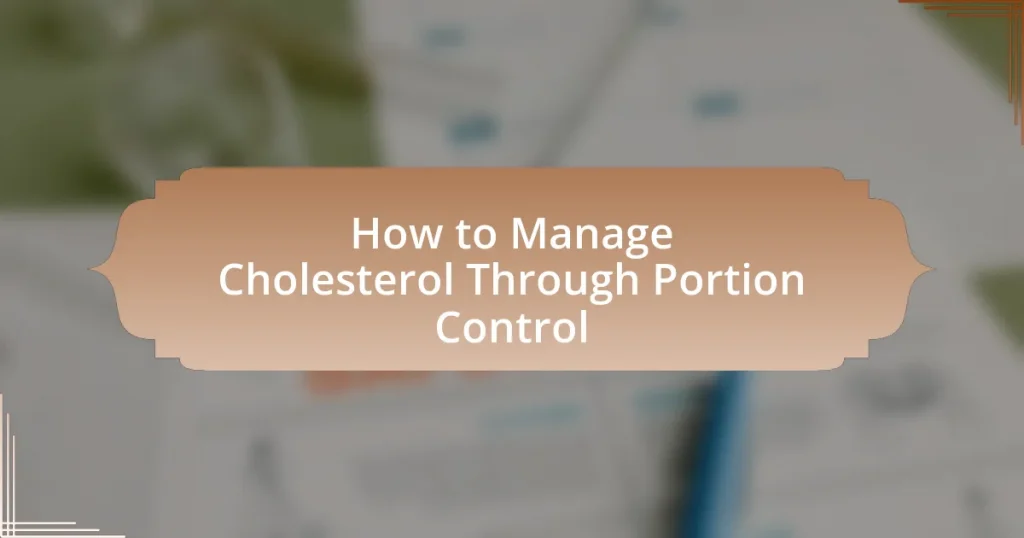Cholesterol management is essential for maintaining cardiovascular health, as imbalanced cholesterol levels can lead to serious health risks, including heart disease and stroke. This article explores the significance of cholesterol, detailing the different types—low-density lipoprotein (LDL), high-density lipoprotein (HDL), and very-low-density lipoprotein (VLDL)—and their respective roles in the body. It emphasizes the importance of portion control in dietary habits to effectively manage cholesterol levels, highlighting recommended portion sizes, beneficial foods, and strategies for implementing portion control. Additionally, the article discusses the impact of saturated and trans fats on cholesterol levels and provides practical tips for healthier eating habits to promote heart health.

What is Cholesterol and Why is it Important?
Cholesterol is a waxy, fat-like substance found in every cell of the body, essential for producing hormones, vitamin D, and bile acids that help digest fat. It is important because it plays a critical role in maintaining cell membrane integrity and supporting various bodily functions. The body produces cholesterol naturally, but it can also be obtained from dietary sources. Maintaining balanced cholesterol levels is crucial, as high levels of low-density lipoprotein (LDL) cholesterol can lead to cardiovascular diseases, while high-density lipoprotein (HDL) cholesterol helps remove excess cholesterol from the bloodstream. According to the American Heart Association, managing cholesterol through diet and lifestyle choices can significantly reduce the risk of heart disease.
What are the different types of cholesterol?
The different types of cholesterol are low-density lipoprotein (LDL), high-density lipoprotein (HDL), and very-low-density lipoprotein (VLDL). LDL is often referred to as “bad” cholesterol because high levels can lead to plaque buildup in arteries, increasing the risk of heart disease. HDL is known as “good” cholesterol as it helps remove other forms of cholesterol from the bloodstream, reducing the risk of heart disease. VLDL primarily carries triglycerides, another type of fat in the blood, and is also considered a risk factor for cardiovascular disease when present in high levels.
How do LDL and HDL cholesterol differ in function?
LDL (low-density lipoprotein) and HDL (high-density lipoprotein) cholesterol differ primarily in their functions related to lipid transport in the body. LDL cholesterol is responsible for transporting cholesterol from the liver to the cells, which can lead to plaque buildup in arteries if levels are too high, increasing the risk of cardiovascular diseases. In contrast, HDL cholesterol functions to transport cholesterol away from the cells and back to the liver for excretion, thereby helping to reduce the risk of heart disease. Studies have shown that higher levels of HDL are associated with a lower risk of heart disease, while elevated LDL levels are linked to an increased risk, highlighting their opposing roles in cardiovascular health.
What role does triglycerides play in cholesterol management?
Triglycerides play a significant role in cholesterol management by influencing the levels of low-density lipoprotein (LDL) and high-density lipoprotein (HDL) in the bloodstream. Elevated triglyceride levels can lead to an increase in LDL cholesterol, which is often referred to as “bad” cholesterol, while simultaneously reducing HDL cholesterol, known as “good” cholesterol. Research indicates that high triglyceride levels are associated with an increased risk of cardiovascular diseases, as they can contribute to the buildup of plaque in arteries. Therefore, managing triglyceride levels through dietary portion control and lifestyle changes is essential for maintaining healthy cholesterol levels and reducing cardiovascular risk.
Why is managing cholesterol levels crucial for health?
Managing cholesterol levels is crucial for health because high cholesterol is a significant risk factor for cardiovascular diseases, including heart attacks and strokes. Elevated levels of low-density lipoprotein (LDL) cholesterol can lead to the buildup of plaques in arteries, which narrows blood vessels and restricts blood flow. According to the American Heart Association, maintaining healthy cholesterol levels can reduce the risk of heart disease by up to 30% to 50%. Therefore, effective management of cholesterol through dietary choices, such as portion control, is essential for promoting overall cardiovascular health.
What health risks are associated with high cholesterol levels?
High cholesterol levels are associated with significant health risks, primarily cardiovascular diseases. Elevated cholesterol can lead to the formation of plaques in arteries, a condition known as atherosclerosis, which increases the risk of heart attacks and strokes. According to the American Heart Association, individuals with high LDL cholesterol (often referred to as “bad” cholesterol) are at a greater risk for coronary artery disease, which is a leading cause of death globally. Furthermore, high cholesterol can contribute to peripheral artery disease, where blood flow to the limbs is reduced, potentially leading to severe complications.
How does cholesterol impact heart health?
Cholesterol significantly impacts heart health by influencing the development of atherosclerosis, a condition characterized by the buildup of fatty deposits in the arteries. High levels of low-density lipoprotein (LDL) cholesterol can lead to plaque formation, which narrows arteries and restricts blood flow, increasing the risk of heart attacks and strokes. According to the American Heart Association, elevated LDL cholesterol is a major risk factor for cardiovascular disease, with studies showing that reducing LDL levels can lower the risk of heart-related events.

How Does Portion Control Affect Cholesterol Levels?
Portion control significantly affects cholesterol levels by regulating the intake of saturated fats and calories. Consuming smaller portions of high-fat foods, such as red meat and full-fat dairy, can lead to lower overall cholesterol intake, which is crucial for maintaining healthy cholesterol levels. Research indicates that diets emphasizing portion control can reduce LDL cholesterol, the “bad” cholesterol, and improve heart health. For instance, a study published in the American Journal of Clinical Nutrition found that participants who practiced portion control experienced a notable decrease in their cholesterol levels over a 12-week period.
What is portion control and how does it relate to diet?
Portion control is the practice of managing the amount of food consumed in a single serving, which directly impacts dietary habits and overall health. By regulating portion sizes, individuals can better manage caloric intake, which is essential for maintaining a healthy weight and preventing chronic diseases, including high cholesterol. Research indicates that smaller portion sizes can lead to reduced calorie consumption, thereby supporting weight management and improving lipid profiles. For instance, a study published in the American Journal of Clinical Nutrition found that participants who practiced portion control experienced significant reductions in body weight and cholesterol levels.
How can portion sizes influence cholesterol intake?
Portion sizes significantly influence cholesterol intake by directly affecting the quantity of cholesterol-rich foods consumed. Larger portion sizes often lead to higher consumption of foods such as red meat, full-fat dairy, and processed snacks, which are known to contain elevated levels of saturated fats and cholesterol. Research indicates that reducing portion sizes can effectively lower overall calorie and cholesterol intake, thereby contributing to better heart health. For instance, a study published in the American Journal of Clinical Nutrition found that individuals who reduced their portion sizes by 20% decreased their cholesterol levels by an average of 10%. This demonstrates that mindful portion control can play a crucial role in managing cholesterol levels.
What are the recommended portion sizes for cholesterol management?
The recommended portion sizes for cholesterol management include 3 to 4 ounces of lean protein, such as chicken or fish, per meal, which helps limit saturated fat intake. Additionally, a serving of whole grains should be about 1 ounce or 1 slice of bread, while vegetables should fill half of the plate, typically around 1 to 2 cups. Fruits should be consumed in portions of 1 medium piece or ½ cup of chopped fruit. These portion sizes are aligned with dietary guidelines that emphasize the reduction of cholesterol levels through balanced nutrition and portion control.
How can portion control be effectively implemented?
Portion control can be effectively implemented by using measuring tools, such as cups and scales, to accurately determine serving sizes. Research indicates that individuals who utilize these tools are more likely to adhere to recommended portion sizes, which can lead to better management of cholesterol levels. For instance, a study published in the Journal of the Academy of Nutrition and Dietetics found that participants who measured their food intake reduced their calorie consumption by an average of 20%. Additionally, visual cues, such as using smaller plates and bowls, can help create the perception of larger portions, further supporting effective portion control.
What strategies can help in practicing portion control?
To practice portion control effectively, individuals can utilize strategies such as using smaller plates, measuring food servings, and being mindful of hunger cues. Research indicates that using smaller plates can lead to reduced food intake, as it creates the illusion of a fuller plate, which can help in managing portion sizes. Additionally, measuring food servings with tools like cups or scales can provide a clear understanding of appropriate portion sizes, which is crucial for maintaining a balanced diet. Mindfulness in eating, including paying attention to hunger and fullness signals, can further enhance portion control by encouraging individuals to eat only when necessary and stop when satisfied. These strategies collectively support better management of cholesterol levels through controlled dietary intake.
How can meal planning assist in managing portion sizes?
Meal planning assists in managing portion sizes by allowing individuals to pre-determine the amount of food they will consume, which helps prevent overeating. By preparing meals in advance, individuals can measure and control serving sizes, ensuring they adhere to recommended dietary guidelines. Research indicates that structured meal planning can lead to a reduction in calorie intake and improved nutritional quality, as individuals are less likely to make impulsive food choices that may exceed portion recommendations. For instance, a study published in the Journal of Nutrition Education and Behavior found that participants who engaged in meal planning consumed fewer calories and had better portion control compared to those who did not plan their meals.

What Foods Should Be Considered for Cholesterol Management?
Foods that should be considered for cholesterol management include oats, fatty fish, nuts, and fruits such as apples and citrus. Oats contain soluble fiber, which can reduce LDL cholesterol levels by binding to cholesterol in the digestive system. Fatty fish, rich in omega-3 fatty acids, can lower triglycerides and improve overall heart health. Nuts, particularly almonds and walnuts, have been shown to lower cholesterol levels due to their healthy fats and fiber content. Fruits like apples and citrus are high in pectin, a type of soluble fiber that can help lower cholesterol. Studies indicate that incorporating these foods into a balanced diet can significantly impact cholesterol levels and overall cardiovascular health.
Which foods are beneficial for lowering cholesterol?
Oats are beneficial for lowering cholesterol due to their high soluble fiber content, which helps reduce LDL cholesterol levels. Consuming oats can lower cholesterol by binding to bile acids in the intestine, leading to their excretion. Studies have shown that a daily intake of 3 grams of soluble fiber from oats can lower total cholesterol by 5-10%. Other foods that help lower cholesterol include fatty fish, which are rich in omega-3 fatty acids, and nuts, particularly almonds and walnuts, which have been shown to improve cholesterol profiles. Additionally, fruits like apples and citrus fruits contain pectin, a type of soluble fiber that can also aid in lowering cholesterol levels.
What role do fruits and vegetables play in cholesterol management?
Fruits and vegetables play a crucial role in cholesterol management by providing dietary fiber, antioxidants, and essential nutrients that help lower LDL cholesterol levels. Specifically, soluble fiber found in fruits like apples and pears, as well as vegetables such as carrots and Brussels sprouts, binds to cholesterol in the digestive system, facilitating its excretion. Research indicates that a diet rich in fruits and vegetables can reduce the risk of heart disease; for instance, a study published in the Journal of the American College of Cardiology found that increased fruit and vegetable intake is associated with lower cholesterol levels and improved cardiovascular health.
How do whole grains contribute to healthy cholesterol levels?
Whole grains contribute to healthy cholesterol levels by providing soluble fiber, which helps reduce LDL cholesterol. Soluble fiber binds to cholesterol in the digestive system, facilitating its excretion and preventing its absorption into the bloodstream. Studies, such as one published in the American Journal of Clinical Nutrition, indicate that a diet high in whole grains can lower total cholesterol levels by 5-10%. This effect is attributed to the presence of beta-glucans and other soluble fibers found in oats, barley, and other whole grains, which have been shown to effectively lower cholesterol levels when consumed regularly.
What foods should be limited or avoided?
Foods that should be limited or avoided to manage cholesterol include saturated fats, trans fats, and high-cholesterol items. Saturated fats, found in red meat and full-fat dairy products, can raise LDL cholesterol levels. Trans fats, often present in processed foods and baked goods, are known to increase bad cholesterol while lowering good cholesterol. Additionally, foods high in cholesterol, such as organ meats and shellfish, should be consumed in moderation. The American Heart Association recommends limiting saturated fat to less than 6% of total daily calories and avoiding trans fats altogether to maintain healthy cholesterol levels.
How do saturated and trans fats affect cholesterol levels?
Saturated and trans fats significantly raise cholesterol levels, particularly low-density lipoprotein (LDL) cholesterol, which is often referred to as “bad” cholesterol. Research indicates that saturated fats can increase LDL cholesterol by 5% to 10% for every 1% increase in saturated fat intake. Trans fats, found in partially hydrogenated oils, can raise LDL cholesterol while simultaneously lowering high-density lipoprotein (HDL) cholesterol, the “good” cholesterol. The American Heart Association recommends limiting saturated fat intake to less than 6% of total daily calories and avoiding trans fats altogether to maintain healthy cholesterol levels.
What processed foods should be avoided for better cholesterol management?
Processed foods high in trans fats and saturated fats should be avoided for better cholesterol management. Trans fats, commonly found in partially hydrogenated oils used in baked goods, fried foods, and snack foods, can raise LDL cholesterol levels while lowering HDL cholesterol levels. Saturated fats, present in fatty cuts of meat, full-fat dairy products, and many processed snacks, can also contribute to increased LDL cholesterol. Research indicates that reducing intake of these fats can significantly improve cholesterol profiles, as evidenced by a study published in the American Journal of Clinical Nutrition, which found that replacing saturated fats with unsaturated fats led to a decrease in total cholesterol levels.
What practical tips can help in managing cholesterol through portion control?
To manage cholesterol effectively through portion control, individuals should focus on reducing serving sizes of high-cholesterol foods and increasing the intake of heart-healthy options. For instance, using smaller plates can help limit portion sizes, making it easier to consume less saturated fat and cholesterol. Research indicates that reducing portion sizes can lead to lower overall calorie intake, which is associated with improved cholesterol levels. Additionally, incorporating more fruits, vegetables, whole grains, and lean proteins into meals can provide essential nutrients while keeping cholesterol levels in check. Studies show that diets rich in these foods can lower LDL cholesterol and promote heart health.










